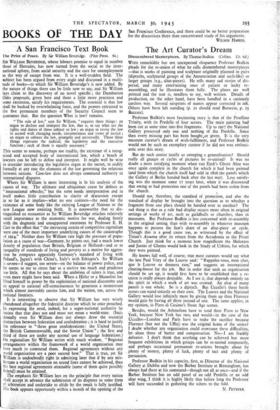The Art Curator's Dream
Dismembered Masterpieces. By Thomas Bodkin. (Collins. 12s 6d.)
Wins remarkable but not unexpected eloquence Professor Bodkin pleads for the re-union of what he calls dismembered masterpieces —that is works of painting and sculpture originally planned in pairs (diptychs, sculptured groups of the Annunciation and such-like) or larger groups (e.g., altar-pieces). He tells many sad stories of dis- persal, and many entertaining ones of patient or lucky re- assembling, and he illustrates them fully. The plates are well printed and the text is, needless to say, well written. Details of production, on the other hand, have been handled in a curiously careless way. Several misprints of names appear corrected in ink. Others have been left standing (p. 21 should read Baroccio, p. 25 Bazzani).
Professor Bodkin's most fascinating story is that of the Pesellino Trinity, with its Predella of four scenes. The main painting had been cut at some time into five fragments. Up to 1917 the National Gallery possessed only one and nothing of the Predella. Since then every missing part has been bought.or given. It is the very museum curator's dream of wish-fulfilment, and Professor Bodkin would not be such an exemplary curator if he did not wax enthusi- astic over this story.
But do such stories justify so sweeping a generalisation? Should really all groups or cycles of pictures be re-united? It was no doubt a most satisfying moment when van Eyck's Ghent Altar was once again complete in the church for which it had been painted (and from which the church itself had sold in 1816 the panels which the Gallery of Berlin handed back after the last war). Less satisfy- ing was the moment some 17 years later, when it was discovered that owing to bad protection one of the panels had been stolen from the church. •
Should not, therefore, the standard of protection, and also the standard of display be brought into the question as to whether a fragment from one place should be handed over to another? The sad thing is that as a rule bad display occurs more often in original settings of works of art, such as guildhalls or churches, than in museums. But Professor Bodkin is less concerned with re-assembly in the original setting than with re-assembly in whatever museum happens to possess the lion's share of an altar-piece or cycle. Though this is a good cause too, as witnessed by the effect of Titian's Assunta after its return from the Accademie to the Friari Church. just think for a moment how magnificent the Melozzos and Justus of Ghents would look in the Study of.Urbino, for which they were painted.
He knows ftill well, of course, that most curators would say what the late Paul Vitry of the Louvre said: "Rappelez-vous, mon cher, que le Louvre ne donnera den," and suggests an international clearing-house for the job. But in order that such an organisation should be set up, it would first have to be established that a re- union is really always desirable. As I see it, that depends entirely on the spirit in which a wo& of art was created. An altar of many panels is one whole. So is a diptych. But Uccello's three battle scenes can stand entirely on their own. The Louvre and the National Gallery would lose infinitely more by giving them up than Florence would gain by having all three instead of one. The same applies, in my opinion, to Piero di Cosimo's Stone Age scenes.
Besides, would the Aslunolean have to send their Piero to New York, because New York has two, and would—in the case of the Uccellos—London and Paris have to make the sacrifice because Florence (but not the Uffizi) was the original home of the series? I doubt whether any organisation could overcome these difficulties, let- alone those of barter and compensation. No—I am frankly defeatist. I don't think that anything can be achieved but more frequent exhibitions in which groups can be re-united temporarily, and perhaps occasional permanent re-unions brought about by plenty of money, plenty of luck, plenty of tact and plenty of persuasion.
Professor Bodkin in his capacity, first, as Director of the National Gallery at Dublin and now the Barber Institute at Birmingham, has always had these at his command—though not all at once—and if the Barber Institute has an odd panel of an odd Predella or an odd altar wing, I think it is highly likely that before long the Professor will have succeeded in gathering the others to the fold.
N. PEVSNER.






















 Previous page
Previous page